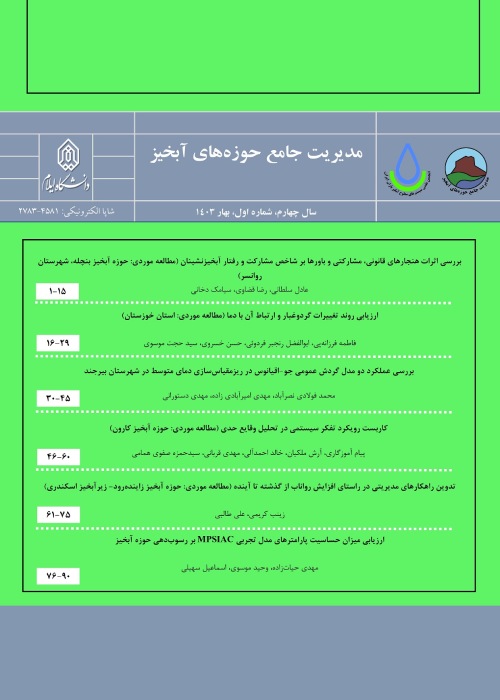Evaluation of dust changes and its relationship with temperature (Case study: Khuzestan province)
Dust storm is one of the desertification and land gegradation consequences especially in arid and hyper-arid regions of the world. Fine particles released from the Earth's surface can be released several kilometers and subsequently over long distances, sometimes even across continents. These particles play a key role in the Earth system by affecting the radiation balance as well as forest and ocean ecosystems. Weather is often considered as the main factor influencing the occurrence of dust storms. Dust storms have increased in recent years mainly due to continued droughts and global warming. Temperature is an important variable in climatilogy in terms of its direct effect on weather variables such as pressure, wind movement, cloud formation and precipitation. Based on previous studies, the increase in temperature along with the decrease in rainfall and the increase in wind speed provide the conditions for the creation of dust storms. In general, the review of the studies conducted in the field of evaluating dust changes and the effect of temperature parameters on it shows that it is possible to conduct these studies from different perspectives and methods. Therefore, it is necessary to find a comprehensive view on dust and factors affecting it by reviewing and evaluating the results of other studies so that the phenomenon can be controlled and managed. The number of dusty days in Khuzestan province is significant and has increased in recent years. The reason for that is its proximity to the great deserts of the neighboring countries. Therefore, this province is one of the challenging areas of the country in the field of dust management and control. The purpose of this study is to evaluate the trend of dust changes and the effect of temperature on this phenomenon. The results of this study help to better understand the phenomenon of dust in Khuzestan province.
In this research, three data groups were used including the monthly average temperature of 13 meteorological stations in the study area, the monthly average land surface temperature (LST), and the monthly average aerosol optical depth (AOD). First, the trend of dust changes was evaluated using the Mann-Kendall test. Then, the relationship between temperature parameters and dust was investigated using the correlation between the AOD in a buffer of 5 km around the selected stationwith temperature parameters including monthly average temperature and average monthly LST in buffers of 5, 10 and 20 km around the selected station.
The evaluation of the average changes in the buffer of 5 km around the selected stations showed that in the months of February, July, December and April, no increasing trend was observed in any of the stations and even in the month of April, there was a decreasing trend in two stations. The trend of AOD changes was increasing with a probability of more than 90% in the months of August, September and November in seven, March in five, October in four, January in three, May in two and June in one station. The correlation results of temperature parameters and AOD showed that a very strong correlation between average LST and AOD has occurred only in the three months of May, June and July in different buffers. There are the highest number of strong correlations in the months of May to August between temperature parameters and AOD. Also, the highest number of very weak correlations occurred in April, March, November, and December. The highest number of very weak and weak correlations are related to air temperature (85 and 47 numbers, respectively). This shows that LST is more important than temperature in evaluating changes in dust intensity in the study area.
According to the results of this research, it can be said that air temperature has a weak correlation with dust, and most of the strong and very strong correlations occurred with the average LST in different buffers, which shows that LST is more important than temperature in evaluating dust intensity changes in the study area. In general, evaluation and monitoring of dust changes can be effective in identifying new dust sources as well as evaluating wind erosion, dust control, and management activities. Therefore, it can be suggested that an online and up-to-date system based on remote sensing and artificial intelligence be designed and presented to evaluate and monitor dust changes. In this case, the management of the dust phenomenon in Iran will be more targeted and the dust sources can be identified faster. On the other hand, one should pay attention to the factors affecting these changes and evaluate their effect on dust.
- حق عضویت دریافتی صرف حمایت از نشریات عضو و نگهداری، تکمیل و توسعه مگیران میشود.
- پرداخت حق اشتراک و دانلود مقالات اجازه بازنشر آن در سایر رسانههای چاپی و دیجیتال را به کاربر نمیدهد.





